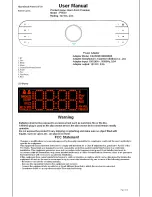
b.
Attach the supplied bracket to the speaker
using the 1/4-20 x 5/8" bolts, washers, and split lockwashers
as shown in figure 2. Do not tighten the bolts at this time.
WARNING
To avoid reduction of sound output and damage to
the speaker, ensure that the speaker is mounted
with the wires exiting from the right side of the
speaker when looking at it from the front.
c.
If necessary, remove the bracket from the
speaker. Using the bracket as a template, scribe four drill
positioning marks at the selected mounting location.
CAUTION
Before drilling holes in ANY part of a vehicle, be
sure that both sides of the mounting surface are
clear of parts that could be damaged; such as brake
lines, fuel lines, electrical wiring or other vital
parts.
d.
Drill 3/16" mounting holes at the position
marks.
NOTE
Some mounting arrangements may require
installing the bracket on the mounting surface
before securing the speaker to the bracket.
e.
Secure the bracket, or assembled unit, unit to
the mounting surface using the 1/4" x 5/8" type B screws
and 1/4" lockwashers as shown in figure 1. Position the
front of the speaker perpendicular to a horizontal mounting
surface or parallel to a vertical mounting surface, and
secure the speaker to the bracket with the 5/16-18 x 3/4"
bolts.
f.
Connect the two leads from the speaker to the
electronic siren’s speaker cable. When two speakers are
used, it is necessary to connect them in phase. This can be
accomplished by connecting the two “red” speaker leads to
one lead of the siren’s speaker cable, and the two “black”
speaker leads to the other siren speaker cable lead. Refer to
the instructions packed with the electronic siren for
additional details.
WARNING
All effective sirens and horns produce loud sounds
(120 dB) that may cause permanent hearing loss.
Always minimize your exposure to siren sound and
wear hearing protection. Do not sound the siren
indoors or in enclosed areas where you and others
will be exposed to the sound.
g.
Test the system for proper operation.
-3-
Figure 2.
DRILL 3/16" DIA. HOLES (4)
USE BAIL BRACKET AS
TEMPLATE
290A5104
VERTICAL
MOUNTING
SURFACE
CUT AWAY
EXCESS
BAIL
BRACKET
LOCKWASHERS (2)
FLAT
WASHERS
1/4" (2)
1/4-20 x 5/8"
HEX HEAD
BOLTS (2)
SK145
SPEAKER
SPEAKER WIRES
LOCKWASHERS, 1/4" (4)
1/4 x 5/8" TYPE B,HEX
WASHER HD. SCREWS (4)
DRILL 3/16" DIA. HOLES (4)
INTO MOUNTING SURFACE.
USE BAIL BRACKET AS
TEMPLATE
290A5105
HORIZONTAL
MOUNTING
SURFACE
HORIZONTAL
MOUNTING
SURFACE
(REF.)
BAIL
BRACKET
BAIL
BRACKET
(REF.)
LOCKWASHER
1/4-20 x 5/8"
HEX HEAD
BOLTS (2)
SK145
SPEAKER
SPEAKER
WIRES
LOCKWASHERS
1/4" (4)
1/4 x 5/8"
TYPE B,
HEX WASHER
HD. SCREWS (4)
OPTIONAL
MOUNTING
OF SK145
SPEAKER
FLAT WASHERS
1/4" (2)


























